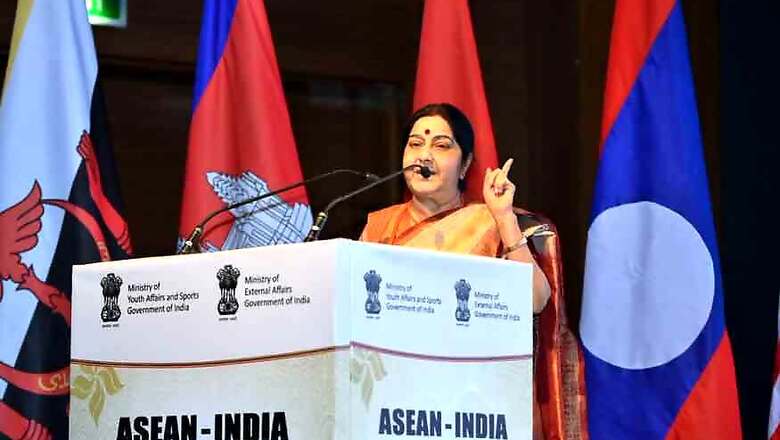
views
New Delhi: External Affairs Minister Sushma Swaraj on Tuesday inaugurated the India-ASEAN youth awards, as a precursor to the Indo-ASEAN commemorative summit. Speaking at the event, she said "Ramayana and Buddhism are two aspects that connect India and ASEAN. Which is why we have kept these two at the centre of this commemorative summit."
This Republic Day will see an extraordinary gathering of all the 10 heads of state of ASEAN countries. All 10 have been invited as Guests of Honour for Republic Day.
While this is seen as a commemorative gesture to mark 50 years since the formation of this group and more importantly 25 years since India established its ‘Look East’ policy under then Prime Minister Narasimha Rao. Of course, Modi has refined ‘Look East’ to ‘Act East’, but the parade and every word uttered there by the visiting guests will be closely monitored in Beijing.
After all, the significance of this move it will not be lost on China. Some countries in ASEAN, like Philippines and Vietnam, have been at loggerheads with China over disputes in the South China Sea. They have been looking to India to play a balancing role to take on China’s ‘hegemonic designs’.
The Prime Minister will be hosting an afternoon retreat with all 10 ASEAN Heads of State at the Rashtrapati Bhavan on January 25. In addition, India and ASEAN will also be celebrating a commemorative Indo-ASEAN summit to mark 25 years since the establishment of formal diplomatic ties between New Delhi and ASEAN.
This will be the first high-level summit after the last East Asia Summit in Manila where for the first time both India and the US used the phrase ‘Indo-Pacific’. Some ASEAN countries have reservations over the use of the phrase Indo-Pacific as it rubs China the wrong way.
The Prime Minister will also be holding standalone bilateral meetings with 9 out of 10 ASEAN heads of state. The only exception is Cambodia which is often perceived as China’s proxy in the 10-member grouping.
More than a third of the world’s total goods are shipped through the contentious waters of the South China Sea. Since the turn of this decade, China has been using a historic but contentious construct of the ‘nine-dash line’ to stake its claim to large swathes of the South China Sea.
This has upset many South East Asian countries, including Malaysia and Indonesia, which have been friendly to China over the years. It was also struck down by the United Nations Tribunal which adjudicated the territorial dispute between China and the Philippines on the Scarborough Shoal.
Interestingly, Chinese President Xi Jinping had first announced the Maritime Silk Route in his address to the Indonesian Parliament in 2013. Indonesia was also one of the first countries to pull out of China’s ambitious One Belt, One Road (OBOR) suspecting China’s growing ambitions in its neighbourhood.
While maritime security is just one aspect, the driver of any bilateral relationship in the 21st century trades. Here, unfortunately, India’s trade with ASEAN is paltry compared to China’s trade with the South East Asian block. Last year India’s trade with ASEAN was about 70 billion USD. China at the same time traded close to 400 billion. Both sides are hoping to take that to 1 trillion by the end of the decade.
India after having wrapped up a free trade arrangement with ASEAN on goods is yet to sign off on a similar agreement for services.
The ambitious Regional Comprehensive Economic Partnership (RCEP) has also been hanging fire for years now. Both sides have had close to 20 rounds of dialogue but issues continue to persist and a breakthrough is unlikely anytime soon.
There is also pressure on India from the US after Donald Trump dumped the Trans-Pacific Partnership to not get into any major multilateral trade arrangement in which China is also an influential member.
But perhaps the single biggest reason why Indo-ASEAN ties are still in second gear has to do with India’s own poor track record when it comes to completing infrastructure projects. Look no further than the India-Myanmar-Thailand trilateral highway which has been hanging fire for over 20 years now. Meanwhile, China has just completed its ground-breaking ceremony for a high-speed rail line that will connect Thailand to China through Laos. You can’t hope to beat a Mercedes while driving an Ambassador. Clearly, India needs more than just Ramayana and Buddhism to woo its South East Asian partners.
















Comments
0 comment